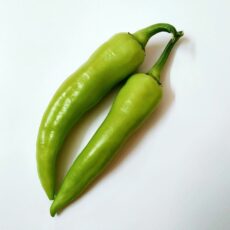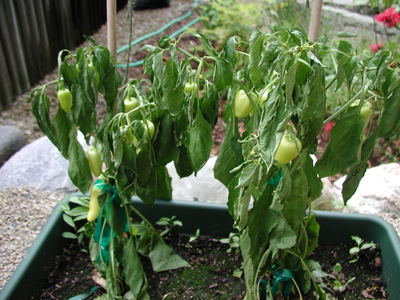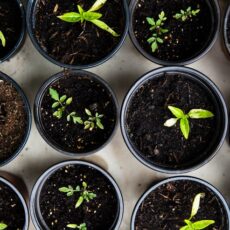Growing chillies is a very rewarding process, but often it’s the simplest things that get in the way of a great chili harvest, follow the advice below, and with a little care and attention you could be enjoying juicy, great tasting chillies in no time.
with a little care and attention you could be enjoying juicy, great tasting chillies in no time.
Germinating your chili seeds
Many of us struggle with germinating chili seeds and getting them out of the ground!
First of all, make sure that you select a good compost or seed mix, and gently work out any hard lumps from the soil.
Then place your chili seeds on top of the soil, planting them roughly 1-2 inches apart if planting multiple chili seeds. Then loosely sprinkle some soil over the seeds, but do not compact.
There are 2 main points that you will need to keep in mind to maximise your chances of germination.
The first one is moisture – you can soak your pot(s) from the bottom using a tray filled with water the first time you water them to saturate the soil and activate your chili seeds.
For maintaining the moisture in the soil it is best to use a fine mist plant sprayer to water from the top. Aim to keep the soil moist but not soggy as this may cause your seeds to rot before them come up – just use your finger to test the surface of the soil.
Watering your seed trays or pots with a plant sprayer causes less disturbance to your germinating seeds.
The second important point to note is temperature. Chili seeds require a constant temperature range of between 27-32 degrees C (80-90 degrees F).
This is easily achieved using a heated propagator, however an airing cupboard works extremely well for this purpose also.
Remember to keep checking your pots to see if any seedlings have emerged, as you will then need to move them to a well lit area such as a sunny window sill, otherwise you will end up with thin and wispy plants.
Re-potting your chili plants into larger pots
When your seedlings get 3 sets of leaves and are strong enough to handle, now is the time to pot them on into a bigger pot. Chillies need to be potted on as they grow, otherwise their growth will slow and you may well miss the fruiting season because of this.
Be careful not to damage the delicate roots when moving your seedlings and make sure you take as much soil as you can from the original pot to protect the root ball.
When potting on your chili plant seedlings, it is better to increase the pot size gradually to allow the plant to adapt to the increased space and grow strong roots.
A good way to tell if your chili plant needs replanting into a larger pot is by checking the drainage holes on the bottom of your pot – if you can see any root tips emerging from these holes, then now is a good time to transplant to a bigger pot.
In addition, if your chili plant suddenly droops for no reason and it has enough water, then this could also be a sign that it requires more space.
You can also plant your chili plant outdoors once the danger of last frost has gone, although chili plants usually grow quicker in warmer areas such as a sunny window sill or greenhouse.
When to water your chili plants and how much
Often overlooked is the importance of watering. One of the most common situations is over-watering. Chili plants like their soil to dry out before watering them again – they don’t like wet feet!
You can tell if your chili plant needs water by its leaves – if they are drooping, give it a drink. The best way is to use your finger to test the top of the soil.
Again, moist but not soggy is the goal here and if your plant looks well, then it probably is.
What to do when your chili plant flowers
Once your chili plant starts to produce flowers, you are doing well! Soon you will be enjoying the fruits of your labour, but now is a good time to highlight the importance of plant nutrition.
A lot is going when your chili plant is in the flowering and fruiting stage and you will need to make sure that your plant has the correct nutrients it requires in order to produce big juicy chillies.
You can feed your chili plant with a general tomato fertiliser as chili and tomato plants are very similar, however it is much better to feed your chili plants with a special chili fertiliser, as they do have specific nutritional requirements – Chili Focus fertiliser produces very tasty and juicy chillies and is organic based.
Remember to feed your chili plant twice a week when it is fruiting and once a week at all other times to make sure it has all the nutrients it needs throughout the different stages of growth. This also makes your plants strong when it comes to “overwinter” them for next season.
Pollinating the flowers on your chili plant
Unless your plants are outside where they are naturally pollinated by insects and the wind, then you will need to pollinate the flowers yourself as they open on your plant.
You can do this with a small soft brush by gently dusting each flower. You will then notice over the next week or so that the flowers start to fall off and the fruits will begin to grow.
Chili plants can also easily cross-pollinate with one another by insects or by air if the plants are close to each other, so if you are growing several different varieties, you may want to keep them apart as you will probably end up with some hybrids chillies.
Finally, make sure your plant gets lots of sunlight during this period and you will have some great tasting chillies at the end of the season!
Overwintering your chili plants for next season’s crop
A common misconception is that chillies are annuals, but they can and will come back year after year, producing more and more chillies each season.
Overwintering, as it is called, is the process of making sure your plant is ready to “sleep” for the winter. Feeding your plant well throughout the year can help make it’s roots and stem strong enough for the cold months ahead.
With a little care, a properly over-wintered chili plant can bring a larger harvest, which will also arrive a little earlier in the season compared to growing from seed again.
This is because when your plant “wakes up” in the spring, it already has an established root ball, so has a head start in the growing cycle.
The first thing to do when overwintering your chili plants is to pick all of the chillies from the plant when the growing season is over – this tells the plant to produce more in future.
Next you can prune back the plant to approximately 1/3 of its original height. This may sound harsh, but it allows the plant to conserve its energy for the next growing season by not having to maintain all that extra foliage, a bit like when you prune back a rose.
You will also need to keep your plants somewhere with a warm average temperature, where it doesn’t get too chilly in the night.
Remember that you plant will also require a lot less water while it is dormant – once every 2 weeks is enough. Again, you can use your finger to test this.
Your plant will slow its growth as it goes into hibernation, so don’t worry if you don’t see any new shoots for a while.
Come spring time, give it a few weeks and your plant will start to shoot and burst into life, read for the new years growing season with more chillies than you ever imagined!
So, what are you waiting for, plant your chili seeds now and soon you could be enjoying plentiful fresh chillies that you can cook and entertain with.


